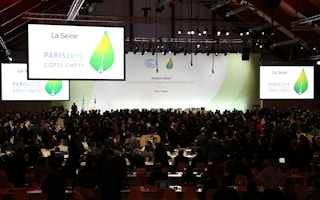Over the next few weeks, Paris will once again dominate global headlines. This time, however, the news is likely to be positive, as world leaders come together to forge a meaningful agreement in the fight against climate change.
To continue reading, subscribe to Eco‑Business.
There's something for everyone. We offer a range of subscription plans.
- Access our stories and receive our Insights Weekly newsletter with the free EB Member plan.
- Unlock unlimited access to our content and archive with EB Circle.
- Publish your content with EB Premium.
To be sure, at first glance, the United Nations Climate Change Conference taking place from November 30 to December 11 looks a lot like the 2009 conference in Copenhagen, when negotiators were unable to agree on an effective accord. And indeed, the desired outcome remains unchanged: an international deal that will reduce greenhouse-gas emissions and limit global warming to 2° Celsius above pre-industrial levels.
But there are notable differences this time around. The stiff economic headwinds that negotiators confronted six years ago have been replaced by a tailwind of opportunity. No longer is the conversation limited to burden sharing and sacrifice; increasingly, there is talk of innovation and technological breakthroughs that make sustainable development possible. In short, the negotiations are taking place in an environment favorable to collective action, with support from the business community, financial institutions, civil society, religious leaders, politicians, and, indeed, the public at large.
Furthermore, the agreement to be reached in Paris is being built from the bottom up. It is clear that whatever shape the agreement takes, it will not be totally top-down. So countries have been asked to propose what they think they can achieve in terms of reducing emissions after 2020, through so-called Intended Nationally Determined Contributions (INDCs). And while this solution may not yet be adequate to the challenge of heading off the consequences of climate change, it is a strong step forward.
“
A global climate agreement remains vitally important. But forging one would no longer be a leap of faith. It would be a leap into open arms.
Meanwhile, in the years since the Copenhagen summit, there has been a surge of concrete progress on the part of the “non-state actors” whose cooperation will be needed to implement an international agreement. An unprecedented number of scientists, business leaders, and subnational government politicians such as mayors and governors have made clear the need for a strong agreement in Paris. Broad support for a robust accord is reflected in the more than 10,000 commitments to combat climate change made by cities, regions, companies, and investors.
This emerging consensus was also reflected in May at the Business & Climate Summit and Climate Finance Day, where investors and business leaders pledged to lead the global transition to a low-carbon economy. Participants at the two events called for setting a price on carbon, phasing out fossil-fuel subsidies, more partnerships with governments, and the coupling of public and private finance to diffuse the risks of low-carbon investments.
And in July, more than 2,000 researchers meeting in Paris at a conference called Our Common Future Under Climate Change concluded that ambitious efforts at mitigating carbon dioxide emissions would be economically feasible and have numerous knock-on benefits. This finding is fully in line with last year’s New Climate Economy report, which established that it is possible to combat climate change while promoting economic growth.
Gradually, funding is being channeled toward regions in need of assistance in the fight against climate change. The OECD estimates that the flows of public and private climate finance reached $62 billion in 2014. And, in October, the World Bank pledged to increase its direct and leveraged climate financing to up to $29 billion annually.
Innovative financing is also becoming more important, especially in developing countries. In February, Yes Bank, India’s fifth-largest private-sector bank, issued the first ever “Green Infrastructure Bond.” In August, the International Finance Corporation issued a five-year “green Masala bond” on the London Stock Exchange. Meanwhile, institutional investors have been snapping up a series of climate bonds focusing on water, affordable housing, smart cities, and an array of other mitigation and adaption projects.
Meanwhile, local-level politicians in cities and regions around the world are often well ahead of their national leaders. At the World Summit Climate & Territories in Lyon in July, 14 networks of subnational and local governments, representing 11% of the world’s population, committed to emission reductions equivalent to 15% of the effort needed to keep global warming below 2° Celsius.
What all these efforts have in common is a desire to compel negotiators in Paris to recognize the urgency of the climate challenge. Their participants want world leaders to understand that progress is not only achievable; it is already occurring. A global climate agreement remains vitally important. But forging one would no longer be a leap of faith. It would be a leap into open arms.
Rana Kapoor is Founder and CEO of Yes Bank. Johan Rockström is Executive Director of the Stockholm Resilience Centre. Khalifa Ababacar Sall is Mayor of Dakar, Senegal. Feike Sijbesma is CEO and Chairman of the Managing Board at Royal DSM.
Copyright: Project Syndicate, 2015.
www.project-syndicate.org














